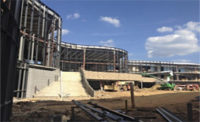With more than a decade of data on sustainability documented at pilot projects around the state, Texas school districts are buying into the promise of green building for K-12 facilities in a big way. Many independent school districts have pursued their first green projects in recent years, while early adopters are pushing for even higher performance standards on upcoming projects. Despite an environment of strained budgets, many observers note that school districts are looking beyond the initial costs of green building in order to reap the long-term rewards.
Gail Vittori, co-director of the Center for Maximum Potential Building Systems in Austin, says that based on the experiences of pilot projects, school administrators are gravitating toward the positive lifecycle benefits of sustainability.
“The economic analysis is positive,” she says. “These are huge investments of public dollars and there is a heightened sense of how to operate schools in a lean way. If you focus on the lean operation of a school, you have to consider the energy performance of that school.
“Mechanical systems with a modest additional first cost can pay back quickly. Even other [green elements] that may have an upfront cost make sense ultimately because these schools will be in operation for decades.”
The Texas State Energy Conservation Office has weighed in on the debate, advocating for green schools that perform better throughout their lifecycles than those built using traditional designs.
Jim Luckey, director of design at SHW Group in Austin, says the message is resonating with administrators. Even as some districts are opting to trim budgets by renovating buildings rather than build new ones, the sustainability argument holds up, he says.
“Just the fact that we’re extending the life of existing buildings is a sustainable act,” Luckey adds. “In many cases, we were able to build stronger and more solid structures in the past. By refreshing the systems, it will give clients buildings that last longer than those we build today.”
Still, new facilities can pay back in a big way. SHW designed the $15.6-million Gloria Marshall Elementary School for the Spring Independent School District near Houston. Sustainable elements of the facility are expected to reap a 25% savings over a traditional design. Purcell Construction of Humble, Texas, is building the 105,000-sq-ft school, which will complete in summer 2011.
Gloria Marshall will be the first school in Houston to use geothermal heating and cooling. The school is designed with a two-story layout for greater efficiency and is oriented to maximize daylight. Studies suggest that classrooms can use daylight rather than artificial light for 75% of the average school day. Additional green features include a reflective roof, wind turbine, 10,000-KW photovoltaic array on the roof and an underground cistern for harvesting rainwater.
The school is designed to meet LEED -gold certification, although SHW project manager Jody Henry says that wasn’t the original goal.
“The president of the [school] board mentioned looking at energy efficiency, and that lit a fire under us,” she adds.
As the team continued to conceive ways to improve the building’s performance, it became clear that the school could achieve a high LEED rating.
The school is also among the first schools in the state designed to meet criteria for Collaborative for High Performance Schools [CHPS], which is the first rating system tailored specifically for K-12 schools. Last year, CHPS released its first Texas CHPS criteria, focusing on state-specific needs. Among the considerations were the varying climate zones in the state and regional logistics, such as the availability of local recycling centers for construction waste.
Ed Sevcik, director of facilities and construction at Round Rock ISD, says Texas CHPS also expands green building to a broader range of districts. Sevcik, who served on the committee that oversaw development of Texas CHPS, says that while schools can choose to pay for third party reviews in the aim of achieving CHPS-verified status, they can also undergo a self-evaluation and earn a CHPS-Design rating. Through CHPS-designed, the team can submit documentation showing that it met the criteria without any addition reviews.







Post a comment to this article
Report Abusive Comment